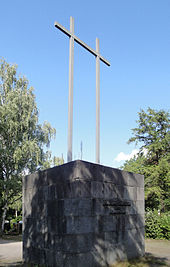Franz Hellinger

Franz Hellinger (born March 24, 1901 in Munich , † January 9, 1924 in Speyer ) was a German political activist. He became known as a participant in the fatal attack by right-wing extremists on the Palatinate separatist leader Franz Josef Heinz in January 1924. Hellinger was also killed in the pursuit of the assassins by Heinz's followers.
Life
Hellinger lost his father, a bank teller, at an early age and grew up in poor conditions in Munich . In 1918, at the age of 17, he volunteered for the Royal Bavarian Landwehr Infantry Regiment No. 1 . Shortly before the end of the First World War , however, he was no longer used at the front. As a sergeant from the army released, he lived as a mechanic and driver in Munich.
There he joined the Bund Oberland . With this he took part in the bloody suppression of the Munich Soviet Republic in April 1919 . He was then involved in various military actions of the Federal Oberland, so in 1920 in the Ruhr area against the Red Ruhr Army and in 1921 in Upper Silesia against the Poles. From May 1, 1920 he was listed as member No. 1472 of the NSDAP .
Also in Munich Hellinger joined the Bavarian Wehrkraftverein , then the Jungsturm Adolf Hitler , the first youth department of the NSDAP; it was founded on March 13, 1922 in Munich. On November 9, 1923, he took part in the Hitler putsch and marched to the Feldherrnhalle .
In the same year Hellinger became a member of the Rheinisch-Pfälzischer Kampfbund , founded in March 1923 by Edgar Julius Jung , a secret society to combat the French occupation measures in the Palatinate. On January 9, 1924, he was involved in the assassination of the Palatine separatist leader Franz Josef Heinz in the Hotel Wittelsbacher Hof in Speyer . While the assassins escaped, Hellinger was fatally injured in an exchange of fire with Heinz's supporters.
Posthumous honors
In the further 1920s and early 1930s, Hellinger was considered a so-called “martyr of the national cause” by the völkisch political right in Germany. Among other things, a working group was founded to create a memorial that was to be dedicated to him and to the Kampfbund member Ferdinand Wiesmann , who was also killed in the Speyer assassination . Finally, a Wiesmann-Hellinger memorial was erected at the Speyer cemetery , which was inaugurated on January 10, 1932 “with great public sympathy”.
Only a few days later, on January 26, 1932, Adolf Hitler ordered that Sturm 1 / II / 1 of the SS "in memory of the party comrade Hellinger who was killed in the shooting of the separatist leader Franz Josef Heinz in future be called 1. Sturm Hellinger" should lead. In contradiction to the party membership recorded in the Federal Archives, Hellinger was not a member of the NSDAP, according to the footnote in the annotated edition of Hitler's speeches and orders. But the Nazi racial theorist Hermann Gauch (1899–1978) also mentioned in a letter to the historian Werner Maser on May 6, 1976 in relation to the Heinz assassination attempt in Speyer that both assassins, Wiesmann and Hellinger, whom he knew personally, were members the NSDAP.
Franz-Hellinger-Strasse in Neunkirchen (Saar) , dedicated in 1935, became the former Gartenstrasse again after 1945; since 1962 it has been called Adolf-Kolping-Straße .
The Wiesmann-Hellinger monument in Speyer from 1932 was maintained into the 21st century and was part of the official city tour on the day of national mourning until 2001 . According to a report by the historian Matthias Spindler on SWR2 on February 23, 2002, the then Lord Mayor of Speyer, Werner Schineller , had maintenance work suspended.
literature
- Gerhard graves, Matthias Spindler: Revolver republic on the Rhine. The Palatinate and its separatists . tape 1 : November 1918 to November 1923 . Pfälzische Verlags-Anstalt, Landau / Pfalz 1992, ISBN 3-87629-164-X .
- Gerhard graves, Matthias Spindler: The Palatinate Liberators. People's anger and state violence in the armed struggle against Palatinate separatism 1923/24 . Pro Message, Ludwigshafen / Rhein 2005, ISBN 3-934845-24-X .
Individual evidence
- ^ Federal Archives (Ed.): NSDAP membership list 1919–1921 . NS 1, no. 3298 .
- ^ A b Institute for Contemporary History (ed.): Hitler. Speeches, writings, orders - February 1925 to January 1933 . tape IV / 3 . Verlag De Gruyter, Berlin, p. 73 (1991-2003).
- ↑ Sigfrid Gauch : Lost and Found. The sources for the novel Vaterspuren . 2010, p. 169 .
- ^ Rainer Freyer: Street names. Multiple street renaming on the Saar. saar-nostalgie.de, accessed on September 19, 2015 .
- ↑ Memorial commemorates the attack. Historischer Verein Speyer, January 25, 2014, accessed on September 18, 2015 (button “ Read more ”).
| personal data | |
|---|---|
| SURNAME | Hellinger, Franz |
| BRIEF DESCRIPTION | German political activist |
| DATE OF BIRTH | March 24, 1901 |
| PLACE OF BIRTH | Munich |
| DATE OF DEATH | January 9, 1924 |
| Place of death | Speyer |
